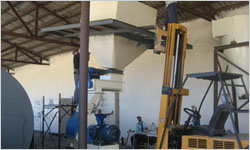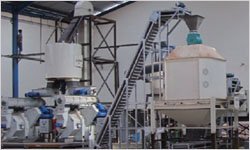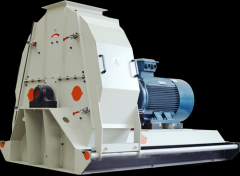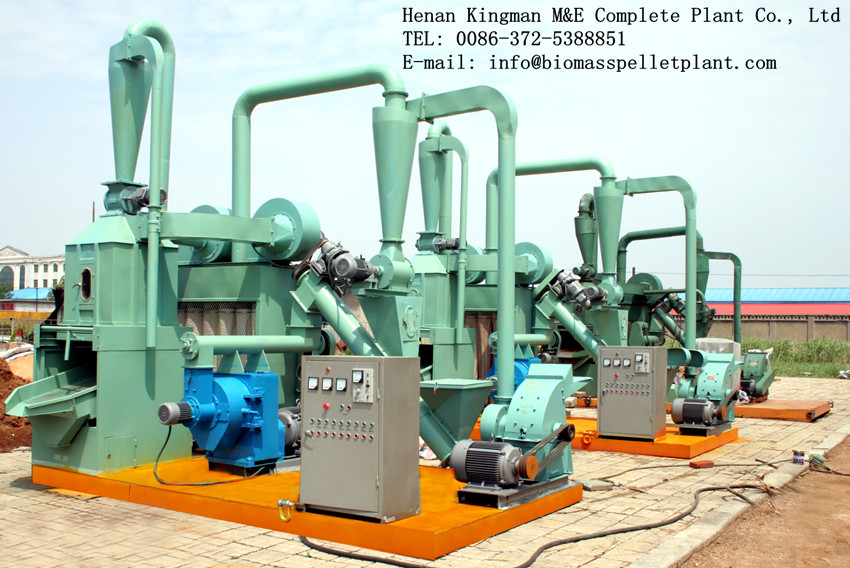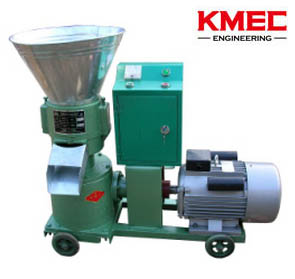Development of wood pellet plant in 2015
In 2015, the import trend of wood pellet plant is still centered in Europe and Untied States. Europe is importing the pellets in ever higher volumes, burning them for electricity to meet renewable energy targets. The demand has transformed the U.S. Industry, promoting a doubling of biomass exports last year. European nations, particularly the United Kingdom, are using wood pellets to replace coal for electricity generation and heating. Under 2009 legislation, the European Union by 2020 plans to reduce its greenhouse gas emissions by 20 percent from 1990 levels and to expand renewable fuels in its energy usage by 20 percent.
Except for home heating, a large number of pellets are used for industrial production to replace of fossil fuel. More than half of the exports go to the United Kingdom, where the utility Drax is converting three of its power plants to burn wood pellets instead of coal. Drax is setting up shop in the U.S to feed those plants, building two pellet mills in Louisiana and Mississippi that are slated to open this year.

Maryland-based Enviva, a Drax supplier, has opened five wood pellet mills in the last four years. At least four additional export-focused plants are under constriction in the South, and a handful of others have been proposed according to a database at Biomass magazine.
A few years ago, about 80 percent of wood pellets produced in the U.S were consumed domestically, mostly for residential heating. Facing high oil costs and a lack of cheaper natural gas during recent freezing winters, Northeasters have driven record demand for wood pellets.
With global demand for wood pellets set to double over the next decade, the pellet plant industry is expanding in the southeastern United States. The south holds about 40 percent of the country’s timberland which has long supplied the lumber, pulp, and paper industries.
A new situation emerges during the development of wood pellet plant. Practically all wood pellets produced in British Columbia since the first major pellet plant was built over 15 years ago have been consumed by energy companies in Europe. However, since late last year, there has been a shift in direction for some of the pellets manufactured in the province; rather than being sent on the 16,000 kilometer long journey to the United Kingdom or the Netherlands, they are being shipped to markets in Asia, a trip that is only about half as far.
South Korea and Japan together imported about 100,000 tons of pellets from British Columbia in the 2Q/14, which accounted for 17 percent of the total exports from the province that quarter, reported the NAWFR . This can be compared to a quarterly average of only 30,000 tons during the period 2010-2012. This shift to markets in Asia is likely to continue because demand for biomass is rising in this region. The reduced shipments to Europe from Western Canada can be expected to benefit other supplying regions to Europe, including the U.S. South, Eastern Canada and Northwestern Russia.
American wood pellet plant
As the big wood pellet producing country in the world, most of the pellets are exported to Europe. Places where near to the raw material for wood pellet and easy to transport to EU has developed with fast speed. Big producer of wood pellet plant has close relation with each other in the aspect of raw materials collection and marketing. Several big pellet plant is going to build or in operation to meet the demand in the EU.
Highland Pellets LLC, an Arkansas, US based company, announced the building of a 500,000 metric ton per year wood pellet plant in Pine Bluff, Ark. Highland Pellets is a privately held company with industry veterans from the wood pellet, finance, and energy markets. Wood pellets are a sustainably sourced feedstock for use by European industrial utilities to lower their carbon footprint and provide sustainable base load power.
Louisiana, an oil-and-gas state, is half covered by timber, making forest products a big business. Companies including Drax Biomass, Biomass Secure Power and German Pellets GmbH plan to churn out wood pellets from new plants here to meet Europe's need for electricity and heat provided by renewable fuels. With its trees, waterways and ports, Louisiana can help quench a growing pellet thirst without deforesting the state, industry members said last week.
Pellets produced by Biomass Power Louisiana will be transported from the plant by a more than mile-long conveyor and then will head in covered barges to the Port of New Orleans, where they'll be transferred to ocean-going freighters for Europe. "Initially, all our production will go to Europe, and we also have several active inquiries from Asia that we're considering," Carroll said. As for the expanded Panama Canal, "we've discussed the canal, and if we complete an agreement with a company in Asia, we'll use it," he said.
"Only about 5 percent of U.S. pellet production is for domestic use, with the rest exported," Vlosky said. "The U.S. South is the nation's wood basket, and it's where further, large-scale pellet manufacturing will continue." About two-fifths of the nation's timberland is in the South.
Wood pellet output in North America, including Canada, swelled from less than a million tons in 2003 to 9.3 million last year, according to combined government data. And production capacity continues to grow.
Through the development to wood pellet is fast, it can not cases new environmental problem like deforestation. Experts said Louisiana won't be deforested by pellet producers. The state's annual tree growth exceeds harvesting, according to the U.S. Forest Service, he noted. New pellet plants provide markets for forest landowners, who have watched other facilities using wood close in the last decade or so. "Market incentives are critical for landowners so that they continue to earn income and invest in and care for their timberland," Vandersteen said. Without forests, rural areas could be turned into shopping centers and other developments. Moreover, "the jobs created by these pellet operations will be substantial from the logging standpoint and for people handling wood at plants and ports," he said.
When growth in trees surpasses removals, timberland is considered sustainable, though that measure must be viewed along with the quality of stands and with biodiversity, according to the U.S. Forest Service.
"Most of the Southern wood fiber required for pellets will be supplied by low-grade materials, including forest cull, pulpwood, thinnings, dead stock, fire-damaged stock and insect-infected materials," Andy Burns, vice president at Biomass Secure Power, said last week. "A reduction in small, stunted, diseased and deformed wood materials promotes the health of the remaining stand," he said. "As the market for wood pellets grows, the quality of Southern U.S. stands is expected to gradually improve."
Companies building pellet plants in Louisiana are sourcing wood and hiring now. Drax Biomass, a U.S. subsidiary of UK electricity generator Drax Group Plc, expects to start up its Morehouse Parish, Luisiana plant in the second quarter of next year. Before that, Drax early next year will begin operating a new Amite, Mississippi pellet facility. After they open, both plants should reach full capacity six months later, Drax spokeswoman Sarah Grazier in New Hampshire said last week. "These two plants are designed to produce 450,000 metric tons of wood pellets per year each, using fiber from actively and sustainably managed forests," she said. Job fairs to attract local applicants were held. "We have fully hired our operations staff of about 50 employees at each facility," she said.
Kelsey Short, Louisiana Economic Development's executive director of business expansion, said the state was able to attract Drax Biomass to Morehouse Parish, which suffered when International Paper shut its Bastrop mill in 2009. Hundreds of jobs were lost then. "The new wood pellet project increases capital investment, employment and business spending locally, without jeopardizing the area's raw material supplies," he said. Other states had hoped to land the plant, and LED gave the company competitive incentives. "Drax chose a site in a rural area that required state support for infrastructure," Short said.
Drax and other pellet producers have been offered incentives under the state's Industrial Tax Exemption and Quality Jobs programs. "Drax, which has a big logistics component with storage and shipping facilities at the Port of Greater Baton Rouge, was the first major prospect in this sector to fully commit to capital investment and job creation in the state," Short said. "We assisted them in a substantial way, reflecting their desire to create development in Morehouse Parish."
Jim Carroll, president of Biomass Secure Power Inc. in British Columbia, said his company plans to start building its Natchitoches Parish Port plant on the Red River in the first quarter of next year, with operations to begin a year later. A 30-year lease for the 75-acre site will be signed by the company's Biomass Power Louisiana subsidiary. "Our annual production goal is one million metric tons," Carroll said. "But it may take us one to two years to hit that target because of a shortage of local forest-industry workers." The plant will need 92 full-time employees and up to 500 people in indirect jobs, including loggers, foresters and truck drivers.
Wood pellet plant in German
Meanwhile, German Pellets GmbH, a top pellet maker based in Mecklenburg, Germany, is building a 1.1 million-ton capacity plant in Urania in La Salle Parish. Infrastructure is already in place from a Georgia-Pacific plywood and particleboard facility that shut there over a decade ago. Under the firm's first phase in Urania, operations were scheduled to begin late this year, with a second phase to be completed by third-quarter 2015. Last week, however, the company didn't respond to inquiries about its start-up date. The new site is slated to create nearly 500 direct and indirect jobs.
German Pellets, one of the biggest producers and providers of wood pellets in the world, completes the commissioning of the first construction phase of the American plant in Urania, Louisiana. Work on the second construction phase has now started. The financing for the capacity increase of the pellet plant from the current capacity of 578,000 to 1,156 million metric tons per year has been raised in full. “We are delighted at the fast realization of the expansion of our second plant in the US and, hence, the increased production,” says Peter H. Leibold, managing partner at German Pellets GmbH.
German Pellets, one of the biggest producers and providers of wood pellets in the world, completes the commissioning of the first construction phase of the American plant in Urania, Louisiana. Work on the second construction phase has now started. The financing for the capacity increase of the pellet plant from the current capacity of 578,000 to 1,156 million metric tons per year has been raised in full. “We are delighted at the fast realization of the expansion of our second plant in the US and, hence, the increased production,” says Peter H. Leibold, managing partner at German Pellets GmbH.
In 2013, German Pellets opened a 500,000-metric-ton plant in Woodville, Texas, shipping from Port Arthur. In addition to supplying power plants, the company fills heating needs for pellets from Europe's private customers, industrial and commercial sites, hospitals and schools.
Richard Vlosky, director of forest sector business development at LSU AgCenter in Baton Rouge, is optimistic about Louisiana's pellet exports. "As long as European Union mandates increase usage of renewable fuels, pellet production in the United States and elsewhere will continue growing," he said last week. "The latest EU mandates have renewable sources supplying 27 percent of the region's energy use by 2030." The European Council set a target of at least 27 percent in October.
Biomass pellet plant can not only process bagasse, stalks and straw but also animals’ forage and fodder. The raw materials cover a wide range of sawdust, twigs, straw, peanut shells and anything you can think the biomass material our small mobile pelletizing system can make them into biomass pellets. Warmly welcome everyone to visit our company and make business negotiation.
Biomass pellet plant can not only process bagasse, stalks and straw but also animals’ forage and fodder. The raw materials cover a wide range of sawdust, twigs, straw, peanut shells and anything you can think the biomass material our small mobile pelletizing system can make them into biomass pellets. Warmly welcome everyone to visit our company and make business negotiation.
----------------------------------------------------------------------------------------------------------------------------------------
How to start a pellet plant is usually raised by clients or potential clients who possess abundant and sufficient biomass material such as wood blocks, wood sawdust or saw shavings, bark, tree branches and twigs as well as rice husk, wheat straw, cotton stalks, maize stalks, corn cobs, bagasse, palm EFB, bamboo.
News
- Small Pellet Machine Manufacturer-Kingman
- Application of Wood Pellets and Use of Biomass Pellets
- From Fossil Fuel into Biomass Pellet Fuel
- Biomass Pellet Making Machines Market
- Applying of pellet stoves for home use
- Highland pellets to build $130 million facility in arkansas
- How to deal with the blocked hammer mill
- How to Make Wood Pellets with Sawdust
- The government policy promotes the development of biomass fuel
- Market analysis of biomass pellet fuel
- Strategic positioning of renewable energy
- Biomass energy has pass through the pre assessment
- The key point of deep processing of biomass pellet
- Harbin is promoting the development of biomass machinery
- The development of biomass formation technology I
- The development of biomass formation technology II
- Biomass energy industry is now going full tilt in 2015
- Rapid increasing demand of sawdust pellet on the market
- Pellet fuel market in EU
- Chinese Biomass Energy Conference held in Beijing
- Future market development of straw pellet mill
- Peanut Shell Pellet Mill Makes High Quality Pellets
- The utilization of straw is only 5%, biomass energy needs our attention!
- Corn straw pellet machine relieves the tight supply of fuel energy
- Reasons for loose or not forming of biomass pellet mill


